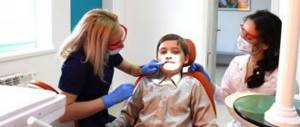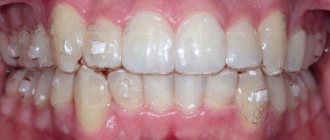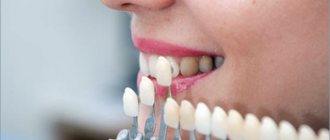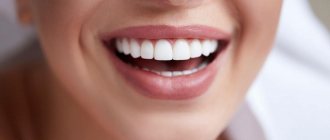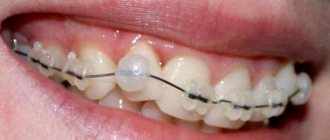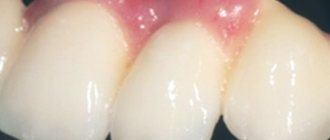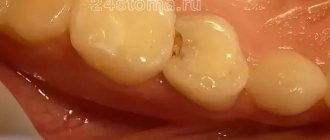Invisible teeth aligners instead of braces
Correcting malocclusion using clear aligners has become widespread around the world since 1998, when the American company Align Technology began producing aligners under the Invisalign® brand.
Important!
The fundamental difference between cap-aligners and braces is that aligners are removable orthodontic structures.
Pros and cons of aligners
Aligners for straightening teeth resemble mouth guards for whitening or for treating involuntary teeth grinding (bruxism). The structures are made from individual impressions of the patient’s teeth in dental laboratories or specialized factories.
Aligners have the following advantages.
- Invisible on teeth. Clear aligners are almost invisible.
- Tight fit. They fit as tightly as possible to the surface of the teeth, due to which they do not cause discomfort in patients.
- Convenience and comfort. In terms of aesthetics, aligners are many times superior to even the most elegant sapphire braces. And compared to lingual appliances, aligners are much more comfortable to wear.
- There are no dietary restrictions or difficulties in care. Removable aligners do not interfere with oral hygiene and normal food intake.
- Safety. Treatment with aligners does not harm the teeth: the enamel retains its original appearance, and the risk of caries does not increase.
Among the disadvantages of aligners, experts note certain limitations in indications, as well as the high cost of treatment for patients.
How is the cost of aligners calculated?
It is better to calculate the cost of the course in advance in order to make a decision and be able to pay for it.
Some manufacturers offer installment payments. To choose a manufacturer of structures for therapy, you need to take into account several factors: not everyone uses 3D technology to make a prognosis, the material is different and has a different effect on the mucosa.
Technologies for creating a three-dimensional model of teeth with step-by-step bite correction and their improvement are carried out by Invisalign, 3D Smile, Star Smile, Avantis 3D. The doctor, together with the patient, sees a program on the computer that simulates the change in his bite over time under the influence of the aligners.
Each manufacturer offers its own 3D setup; this is included in the price of the aligners, since the program was developed with the participation of experienced dentists. And thanks to the program, it is possible to show effectiveness and efficiency with a high degree of accuracy.
Orthosnap does not have such a program, so patients do not pay for the setup. The onlays are made as follows: impressions are taken from the teeth, plaster models are created, according to which the trays are formed. There is a possibility of inaccurate execution; this requires adjustment. Time is wasted transporting the plaster model to the USA.
Star Smile offers free visualization of the final effect after. This makes it possible to save from 5,000 to 55,000 rubles. Avantis 3D offers its clients free consultation and setup, as well as therapy development.
Before starting therapy, it is better to know in advance approximately how much you can expect in order to make a choice. We recommend consulting with several specialists.
You can take advantage of all the free offers from different clinics to find out which option is best in your case. After considering all the ways to correct crooked teeth, you can make an objective decision.
The full price of therapy differs from different manufacturers for several reasons:
- Country of Origin.
American aligners are more expensive due to transportation, consultations with foreign specialists, the material of the product, and the exchange rate at the time of payment.
- The severity of the pathology.
To achieve the desired therapeutic effect with a mild degree of anomaly, a smaller number of corrective units is needed. This reduces the overall cost of therapy. In the case of a severe defect, the number of parts and visits to the doctor for control increases, which increases the price.
- Brand popularity.
Products from well-known brands with extensive experience are a priori more expensive than those from dental services that have recently appeared on the market.
- 3D setup.
Companies that do not use the 3D setup (Orthosnap) do not include its cost in the total price, which means the final figure will be slightly lower. But the lack of three-dimensional prediction of the result can negatively affect the course of occlusion correction itself. We have to change therapy along the way, make new mouth guards that were not planned earlier, which increases the time frame.
- Product material.
Manufacturers with extensive experience in creating aligners have time-tested quality aligners. The risk of developing allergies and irritation is minimized. In general, the material used is the same, with the exception of minor differences. Its quality is constantly improving.
Treatment with aligners
To achieve the best treatment results, aligners should be worn around the clock if possible, removing them only for hygiene procedures and during meals. Each pair of aligners in the patient's personal set is used for a certain period and then replaced with the next one. The duration of treatment with aligners coincides with the duration of bite correction with braces and varies from 9 months to 2 years, depending on the characteristics of the anomaly and how responsibly the patient follows the doctor’s recommendations during the treatment process. Previously, bite correction with aligners was performed only on adults and adolescents who had formed a permanent bite and had already completed jaw growth. Today there are special aligners for children, approved for use from 6 years of age.
The aligners should be washed regularly with warm water and a special cleaning agent recommended by the manufacturer. You should not smoke in them, as this may cause discoloration of the structure. The frequency of visits to the orthodontist to monitor the treatment process and correction is approximately once every 2 months.
OrthoSnap (“OrthoSnap”)
Aligners for teeth straightening as in the photo below are OrthoSnap (USA). They appeared on the Russian market in 2010. Made from transparent polycarbonate, which is approved for use in world dental practice, is hypoallergenic, and does not cause irritation to the mucous membranes.
The photo shows OrthoSnap aligners
The manufacturer emphasizes that the model was created taking into account the experience of competitors and compares favorably with similar ones according to several criteria:
- instead of computer 3D scanning, a physical real model is used to make aligners, which exactly copies the jaws of each individual patient,
- in one set, mouthguards can have different thicknesses, which is convenient if the teeth on the same jaw require different forces of influence,
- the cost of treatment is 30% lower2 than competitors, which is extremely beneficial for many patients.
The delivery time for aligners created from impressions of the patient's teeth is approximately 4-7 weeks. They are produced only in the USA, which is what the manufacturer especially emphasizes. Therefore, if you are offered Russian-made OrthoSnap in the shortest possible time, then we are talking about a fake.
OrthoSnap must be worn 20 to 22 hours per day. You need to replace the old kit with a new one every 10–15 days. The last aligner in the series acts as a retainer and is worn during the final phase of treatment for about 4 months for 6–12 hours every day. It is permissible to use these mouth guards only from the age of 12, when the primary bite has changed to a permanent one.
“As a student, I had the sad experience of wearing braces - it was uncomfortable, and I was dissatisfied with the result, because... The teeth then moved apart again. Later I decided to return to the issue, but they again offered me braces - I was in despair. I started looking on the Internet and came across reviews about OrthoSnap, they are made in New York. I asked the doctor, and he started saying that this was advertised bullshit... As I understand now, he simply did not know the technology and it was easier for him to “sell” braces to everyone. I purposefully went looking for those who work with mouthguards and didn’t regret it one bit - they are comfortable, completely invisible, don’t spoil your diction, and if necessary, you can easily take them off and eat or brush your teeth.”
Sophia, review from the dental portal gidpozubam.ru
Indications and contraindications for aligners
Almost all types of aligners are effective in correcting large spaces between teeth, eliminating crowding, and various malocclusions. Their use to consolidate the effect after treatment on braces also gives good results. Each brand of aligners has its own specifics, and manufacturers often indicate in which cases treatment using aligners is appropriate. Unfortunately, not all types of transparent aligners can correct severe crowding or serious malocclusions.
Stars who wore aligners
Most celebrities cannot afford to wear braces, so Invisalign aligners have become a real salvation for them.
Gisele Bündchen
The only flaw in Giselle's appearance was once a crooked front tooth, for the sake of straightening which she put on aligners.
Zac Efron
Many celebrities are proud of their gap hair, but not Zac Efron. The gaps between his front teeth gave him a rustic appearance. Thanks to wearing aligners, the actor’s appearance changed dramatically.
Khloe Kardashian
Socialite Chloe always thought she had uneven teeth and wanted to fix them, but only decided to undergo orthodontic treatment last year.
Justin Bieber
A favorite of teenage girls, sweet-voiced Justin would never agree to ruin his image and put braces on his teeth. The Invisalign system helped him achieve his perfect smile.
Eva Longoria
Desperate housewife Eva Longoria is rarely tormented by doubts. I decided to correct my crooked teeth - I chose Invisalign - and that was the end of it!
Manufacturers of teeth straightening aligners
Which aligners are the best? Today, orthodontists can offer patients several options for mouthguards from different manufacturers. Let's take a closer look at the pros and cons of aligners from the most popular brands.
- Invisalign
In 1998, the American company Align Technology released clear aligners under the Invisalign brand. They were the first to appear in Russia. Today, Invisalign aligners are manufactured at Align Technology factories and are used to treat malocclusions of varying degrees of complexity. A set of aligners from the manufacturer's factory is delivered to the clinic on average within 14 days from the date the doctor confirms the treatment plan. - Star Smile
Aligners are manufactured in Russia at the company's production center. Production time - 10 days. - OrthoSnap
Following Invisalign, OrthoSnap aligners appeared on the American market, which from the very beginning of their existence began to be presented as an inexpensive alternative to the well-known brand. Bracket-free dental treatment with OrthoSnap aligners was actually cheaper at first, but had a number of significant disadvantages. The fact is that the structures were made in a regular dental laboratory using plaster models (Invisalign and Star Smile use 3D models). As for indications, there are not many anomalies that can be treated with OrthoSnap.
Comparison table of aligners from different manufacturers
| Brand | Production | Indications | Efficiency |
| Invisalign (USA) | High-tech production under the supervision of dental technicians with special education. | Most abnormalities in the position of teeth and bite. | Predictable results regardless of the duration of treatment. |
| Star Smile (Russia) | Own production center in Russia. | Most abnormalities in the position of teeth and bite. | Predictable results with a 5-year guarantee. |
| OrthoSnap (USA) | Standard production in a dental laboratory. | Crowding, gaps between teeth, lengthening or shortening of teeth; crossbite. | Unpredictable result. |
In addition to the above brands, there are also many other less popular manufacturers on the Russian dental market. Often such mouthguards are passed off as brands familiar to the patient. Therefore, you should choose an orthodontist on the official website of the manufacturer to avoid becoming a victim of deception.
How is Invisalign treatment performed?
Straightening teeth and correcting bites with Invisalign has certain features and advantages. Compared to classic braces, the Invisalign mouthguard is completely invisible, does not affect diction, does not require any diet, does not complicate daily hygiene, does not injure or rub the tissues of the oral cavity. The system also does not cause such long-term painful sensations as braces, since the movement of teeth occurs in doses and in stages. Each kappa is one “step”.
Stages of teeth straightening with Invisalign
Step one.
At the initial consultation, a thorough diagnosis is carried out to make a diagnosis and plan treatment, preparatory therapy is prescribed (if required), oral sanitation and professional cleaning are carried out.
Step two.
Impressions are made of the patient’s jaws, from which the most accurate anatomical models are made. A photo protocol is being carried out. Based on the results of diagnostics and measurements in the special Clean Check program, future treatment is planned step by step and a 3D model is created. Using the program, it is possible to see the entire process of teeth movement and evaluate the future result.
Step three.
All necessary information is sent to the Align Technology laboratory, and a set of Invisalign aligners are manufactured in a certified factory located in the States.
Step four.
After receiving orthodontic aligners, the attending physician schedules an appointment at which he helps the patient put on the first pair, explains the treatment technology, issues the remaining sets of replacement aligners, gives recommendations for wearing and daily care, and sets a date for the next visit. Unlike braces, which require regular tightening on average once every three to four weeks, control visits to the orthodontist for Invisalign treatment require significantly fewer follow-up visits.
Step five.
Direct treatment with Invisalign takes about the same time as with braces: from six months to two years. You need to change your aligners about once every two weeks, and visit a doctor only once every one and a half to two months. The main rule and the key to success is to wear Invisalign aligners at least twenty hours a day, removing them only for meals and daily hygiene. The structure must be cleaned by soaking in a special solution, which is provided along with the aligners themselves, and the teeth must be brushed as usual - in the morning, in the evening before bed and after each meal.
Step six.
After completing treatment with Invisalign aligners and achieving the desired result, you will need to wear retainers for some time in order to consolidate the effect and prevent the teeth from returning to their original position.
Photos before and after Invisalign treatment
Where to start correcting your bite with aligners?
The first step is to go to the clinic and consult with an orthodontist. Only a doctor can say for sure whether correcting your bite with aligners will be effective in your particular case. Before making a final decision on treatment with mouth guards, it is better, if possible, to listen to the opinions of several specialists, whose contacts are often indicated on the websites of mouth guard manufacturers. Typically, these orthodontists have a certificate of completion of training/training confirming their professional skills in using aligners.
Are aligners cheap or expensive?
How much do aligners cost to straighten teeth? The average cost of treatment with Invisalign aligners in Moscow, depending on the clinic, is 160,000–300,000 rubles. Next come the OrthoSnap aligners, the minimum cost of which is 140,000 rubles. The price of treatment using Star Smile aligners starts from 80,000 rubles and reaches 165,000 rubles in the regions and up to 195,000 rubles in metropolitan clinics.
When finding out the price of treatment for certain aligners, you should immediately clarify whether it includes diagnostics and a treatment plan. Clinics often announce the lowest cost limit, which is applicable only in simple cases that are very rare. You should also inquire about the possibility of replacing the trays if they are damaged or lost. Often, the excessively low cost of transparent cap-aligners in some clinics entails additional costs, which the patient is informed about during the treatment process.
If you have already decided on treatment, then in the case of some aligner systems, be prepared to make an advance payment for diagnostics and 3D planning in the amount of 20,000 rubles.
Braces and Invisalign - which is better?
Braces and Invisalign work equally well. It is a mistake to believe that mouthguards will be less effective than traditional braces. If you decide to see an orthodontist and can't decide between Invisalign and braces, schedule a consultation with several specialists. However, it must be taken into account that every doctor prefers to work with the system that is familiar to him. For this reason, even a competent orthodontist who does not work with aligners, but successfully treats with classic braces, may decide that orthodontic aligners are not suitable for you.

